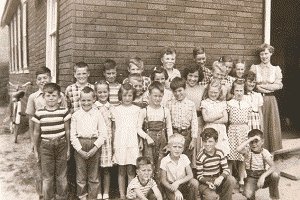|
Back to Settlements Introduction Overview Farming Church Hall Transportation Everday Life |
School Section #3 Parkinson and Grassett As with most early settlements, one of the first priorities for the settlers of the townships of Parkinson and Grassett was their children's education. Prior to 1907, parents wanting their children to go to school had to send them to the school in the settlement of Goldenburg, 10 miles distant. With the distance being that great, the need for a school was keenly felt. In 1905 a board of school trustees was formed to tackle the problem of starting a school. In 1906, the school trustees bought one acre of land from William McAulay. In the spring and summer of 1906, the land was cleared and a frame building was erected. In January of the following year, the school opened with a roll of 12 students. The school trustees were responsible for the smooth running of the school. They set mill rates, assessed property, hired teachers and caretakers, and facilitated the development of the school. Students brought water for the school from springs or wells which were close to the school.There is a recollection by one former student of a time when the water was brought from a spring just a short distance west of the school. One Saturday while working in the corner of the field, he met the teacher who was out walking with one of her students. She told him that they had been for a walk down to the spring and had timed this walk, and found it took only fifteen minutes, walking slowly. She had sent two boys down for water one day at recess and they hadn't returned until almost lunchtime. In the winter in the school there would occasionally be hot lunches-sometimes soup, with the students bringing something to put into the soup. 
In the one room school, classes were arranged by groups. The teacher would have the work for the morning on the blackboard when the students got to school in the morning. When they came in from lunch the work for the afternoon would be on the blackboard. Classes in the school went through to grade eight. Students of the school could sometimes take grade nine, but more often went to Thessalon, boarding through the week and attending highschool. In later years they were bussed to Blind River. In 1934 the first school fair was held in the Kynoch community hall, with participants from both the Parkinson and Wharncliffe schools. In all, six annual school fairs were held. The school was closed twice between the years 1942 and 1944, due to low enrolment. The school reopened in 1946 with a roll of 8 students. In 1945 a township school area was formed consisting of Wells, Gould, Parkinson and Grassett. With the advent of Hydro in 1954, electric lights replaced the old gas lanterns. Government centralization of all schools led to the closing of the school in 1967.This was not the desire of either the parents or the students. Students were bussed to Iron Bridge, ending the era of the one room schoolhouse. Return to Top |
Home | Natural Environment | History | Industry | Personalities/Stories | Credits/Team